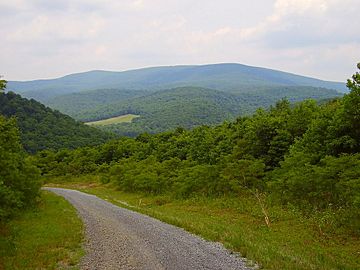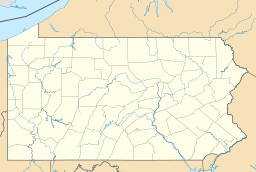Blue Knob (Pennsylvania) facts for kids
Quick facts for kids Blue Knob |
|
|---|---|
 |
|
| Highest point | |
| Elevation | 3120+ ft (951+ m) NGVD 29 |
| Prominence | 800 ft (240 m) |
| Geography | |
| Parent range | Allegheny Front |
| Topo map | USGS Blue Knob |
| Climbing | |
| Easiest route | Drive-up via Knob Road |
Blue Knob is a tall mountain in Pennsylvania. It has a wide, rounded top and is the most northern peak over 3,000 feet (914 meters) in the Allegheny Mountains. It's also the highest point in Bedford County.
This mountain is home to Blue Knob State Park, which covers about 5,874 acres (23.77 km2). The park has around 18 miles (29 km) of hiking trails and many amazing viewpoints. There's also a ski area on the northern side of the mountain. Towns like Johnstown, Altoona, and Bedford are all within 25 miles (40 km) of Blue Knob. The smaller towns of Pavia and Claysburg are right at the base of the mountain.
Contents
Exploring Blue Knob's Surroundings
Blue Knob has several smaller peaks nearby. These are like its "satellite" mountains:
- Herman Point is 3,034 feet (925 m) tall.
- Spruce Knob is 2,475 feet (754 m) tall.
- Round Knob is 2,791 feet (851 m) tall.
- Cattle Knob is 2,842 feet (866 m) tall.
- Pine Knob is 2,704 feet (824 m) tall.
- Ritchey Knob is 2,865 feet (873 m) tall.
- Schaefer Head is 2,950 feet (900 m) tall.
From Blue Knob, you can see many other mountains and landscapes. To the north, you might spot Brush Mountain (about 17 miles away) and Schaefer Head (2.5 miles away). You can also see parts of Tussey Mountain and Lock Mountain.
Looking east, you'll see Dunning Mountain (7 miles away) and Tussey Mountain (16 miles away). On a clear day, you might even see Jacks Mountain with Butler Knob (31 miles away) and Sideling Hill (28 miles away). Even further, Big Mountain and the Tuscarora Mountain Ridge are visible. To the south, you can see Wills Mountain (32 miles away) and Savage Mountain (28 miles away).
If you look west, you'll see Laurel Hill and the Conemaugh Gorge.
Waterways Around the Mountain
Many streams flow from Blue Knob. Some of the main ones include Big Lick Branch, Rhodes Run, Pavia Run, and Beaverdam Creek. Bob's Creek, which is in the valley below the mountain, is known for its trout and is a favorite spot for local fishermen.
How Blue Knob Was Formed
Blue Knob and its nearby peaks form a special group of mountains called a massif. They stand out from the rest of the Allegheny Front and are among the highest points in Pennsylvania's Allegheny Mountains.
The lower part of Blue Knob is made of soft rocks like siltstone and shale. But the upper parts and the very top are made of much harder rocks like sandstone and conglomerate. These harder rocks resist weather and erosion, which is why the mountain stands so tall. The rocks near the top often look bluish-green, which is how Blue Knob got its name!
A Look Back in Time
For a long time, people thought Blue Knob was the highest mountain in Pennsylvania. But in 1921, the U.S. Geological Survey found a higher peak, which was later named Mount Davis.
In the 1950s, the top of Blue Knob was cleared. It became the site of the Claysburg Air Force Station, which was a military base. This station closed in 1961. Soon after, the Blue Knob Ski area was built. You can still see signs from the old Air Force station on the summit, and one of its buildings is now used as a ski lodge. Today, the top of Blue Knob has ski lifts, a lodge, and some maintenance buildings for the ski resort.
Blue Knob's Weather
Blue Knob is known for its snowy winters. The state record for snowfall was set here in the winter of 1890–91, with 225 inches (5,700 mm) of snow! In December 1890 alone, 86 inches (2,200 mm) fell. On average, Blue Knob gets about 12 feet (3.7 m) of snow each year. Temperatures on the mountain are usually 10 to 12 °F (5.6 to 6.7 °C) cooler than in the nearby towns.
The mountain's height and how it faces the wind cause its unique weather. Blue Knob rises about 500 feet (150 m) above the plateaus to its west and over 1,500 feet (460 m) above the lowlands to its east. The strong prevailing winds hit the mountain, rushing up and over its bare summit. This can make the wind chill feel very cold, often dropping below zero degrees Fahrenheit during winter.
Plants and Trees
You can find different types of trees on Blue Knob. Along the streams on the lower slopes, there are Eastern hemlock trees. The drier east and southeast sides of the mountain have mostly Red and White oak trees, along with maples and grapevines.
The north and west sides of the mountain have richer soil, so you'll find trees like Tulip poplar and American beech. On the higher slopes, the trees include Black Cherry, Striped Maple, and Scrub Oak. The ground here is covered with blueberry bushes and ferns. Above 3,000 feet (910 m), the trees are noticeably shorter and twisted because of the strong winds and harsh weather.
In September 2004, during Hurricane Ivan, very strong winds blew through the area between Herman Point and Blue Knob. Many large trees were knocked down, creating open spaces in the forest.
Animals of Blue Knob
Wildlife is plentiful on Blue Knob. You might see animals like white-tailed deer, ruffed grouse, turkey, coyote, porcupine, and fox. While they can be hard to spot, you might find their tracks in the snow. Black bears also live on the mountain and are most often seen in the early morning or evening. Many birds, such as Red-tailed hawks, warblers, and songbirds, can be found here throughout the year.
Next to the state park is the Pennsylvania State Game Lands No. 26, which covers 11,926 acres (48.26 km2). When combined with the park, this creates over 17,000 acres (69 km2) of public land where animals can roam freely. Some areas in Blue Knob State Park are closed to hunting, so hikers should be extra careful during hunting season, which is usually in late November and December.







